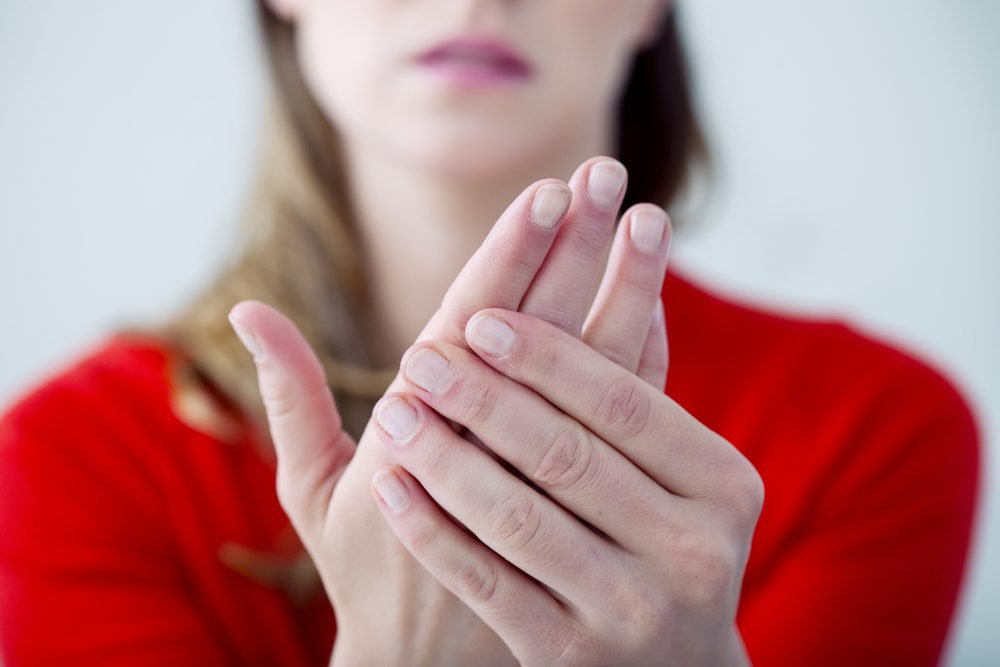Interrupting the Chain: How a Small Injury Can Lead to Others
Written by |

Injuries happen just like that. It’s usually senseless: a step taken too soon, an unexpected encounter with a door jamb, lifting a handbag on the way out, driving a car. A small, random action can cause a dislocation or subluxation and change the course of the next few days, or even the next month, for someone living with Ehlers-Danlos syndrome (EDS).
An injury can be made worse or take longer to heal due to the way EDS affects the very structure of the body. However, the damage does not have to be serious to sideline me. It can be a nuisance injury that sets off a chain of other nuisance injuries, usually because of my body compensating for pain.
I’ve learned the routine
It goes a little something like this: A rolled ankle causes me to favor its partner, which causes me to walk differently, shifting my normal center of gravity. That makes it more difficult to determine my position in space, so I walk into door jambs. I will hurt for several days and not sleep very well, which makes me fatigued, and when I am fatigued, my muscles get lazy and don’t hold my bones in place very well. So, lifting a seemingly insignificant thing like my handbag can cause the tiny bones in my wrist to separate. They usually clunk back together with a little convincing.
Another common chain for me involves driving long distances. Holding the steering wheel for a long time can cause my hands and wrist to hurt for days. Also, if I am not actively engaging my core muscles to support my body while driving, my neck and back get rather irritated. The constant use of my muscles to keep myself upright and in the correct position to drive safely causes my body to drag with fatigue for days afterward.
When I am severely fatigued, I tend to rest on the sofa for long periods, which causes ribs to migrate inappropriately — as if anything migrating would ever be appropriate — and various other misfortunes follow.
Avoiding or interrupting the chain of injuries
Days will pass between the last event in a chain and the next cascade. On those days, I am mindful to pace myself. I want to accomplish as much as possible when I am able, but I don’t want to be so enthusiastic about the ability to function that I inadvertently overuse something or exhaust myself. As I practice better self-care, the number of days I can function increases. Regular activity motivates me to want more regular activity. It keeps me from sinking when I experience an event or series of events.
Adjustments can be small or large
Self-care has required making changes. Many of the adjustments I have made are small and build upon each other to lessen the frequency and severity of injuries. I have written before about using body mechanics techniques and household appliances to help reduce strain on my body.
I have also made some bigger changes. For example, I have changed my vehicle from an SUV to a sedan. I made the switch for economic reasons; I didn’t anticipate the added benefit of a sedan being easier on my body to drive. The cozier fit and the decrease in motion required from my body to maneuver a vehicle that is closer to the road has made driving much less problematic. Knowing how that change has affected me informs the rest of my purchasing decisions.
What about you?
Tell me about your chains or senseless injuries and how you manage them in the comments below. There’s camaraderie to be found in the absurdity of it all, and we can learn coping strategies from one another.
***
Note: Ehlers-Danlos News is strictly a news and information website about the disease. It does not provide medical advice, diagnosis, or treatment. This content is not intended to be a substitute for professional medical advice, diagnosis, or treatment. Always seek the advice of your physician or other qualified health provider with any questions you may have regarding a medical condition. Never disregard professional medical advice or delay in seeking it because of something you have read on this website. The opinions expressed in this column are not those of Ehlers-Danlos News or its parent company, Bionews Services, and are intended to spark discussion about issues pertaining to Ehlers-Danlos.



Kara Jones
Hello!! My name is Kara and my daughter, Caroline, was just diagnosed with EDS and just started PT. She is only 14 and has already dislocated her right shoulder 12 times since Sept, her knee twice and her ribs when she was around 10 yrs old. On top of it, she fell off the school bus last night and landed on her tail bone!! I feel like we have a great EDS dr just down the street, luckily!! I know there aren't many EDS drs around. I was just wondering if you might have any advice for us?? Does this typically progress as the person ages? This is all kinda new to us and it feels overwhelming. I just feel so bad when she is in so much pain... like last night after the fall. Any advice is much appreciated... and my daughter is native Texan as well.... lol Thanks!!
Kara